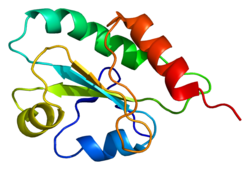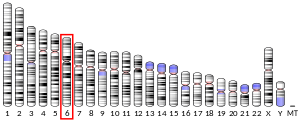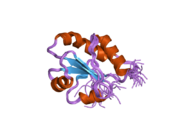| TXNDC5 |
|---|
 |
| Available structures |
|---|
| PDB | Ortholog search: PDBe RCSB |
|---|
| List of PDB id codes |
|---|
2DIZ, 3UJ1, 3UVT, 3WGD, 3WGE, 3WGX |
|
|
| Identifiers |
|---|
| Aliases | TXNDC5, ENDOPDI, ERP46, HCC-2, PDIA15, STRF8, UNQ364, HCC2, thioredoxin domain containing 5 |
|---|
| External IDs | OMIM: 616412; MGI: 2145316; HomoloGene: 11125; GeneCards: TXNDC5; OMA:TXNDC5 - orthologs |
|---|
| Gene location (Human) |
|---|
 | | Chr. | Chromosome 6 (human)[1] |
|---|
| | Band | 6p24.3 | Start | 7,881,517 bp[1] |
|---|
| End | 7,910,788 bp[1] |
|---|
|
| Gene location (Mouse) |
|---|
 | | Chr. | Chromosome 13 (mouse)[2] |
|---|
| | Band | 13|13 A3.3 | Start | 38,684,055 bp[2] |
|---|
| End | 38,712,800 bp[2] |
|---|
|
| RNA expression pattern |
|---|
| Bgee | | Human | Mouse (ortholog) |
|---|
| Top expressed in | - duodenum
- rectum
- stromal cell of endometrium
- appendix
- lymph node
- spleen
- smooth muscle tissue
- placenta
- islet of Langerhans
- body of pancreas
|
| | Top expressed in | - lacrimal gland
- calvaria
- salivary gland
- pyloric antrum
- molar
- parotid gland
- external carotid artery
- submandibular gland
- crypt of lieberkuhn of small intestine
- seminal vesicula
|
| | More reference expression data |
|
|---|
| BioGPS | |
|---|
|
| Gene ontology |
|---|
| Molecular function | - protein binding
- isomerase activity
- protein disulfide isomerase activity
| | Cellular component | - lysosomal lumen
- endoplasmic reticulum lumen
- extracellular exosome
- endoplasmic reticulum
- extracellular region
- azurophil granule lumen
| | Biological process | - apoptotic cell clearance
- negative regulation of apoptotic process
- protein folding
- cell redox homeostasis
- response to endoplasmic reticulum stress
- neutrophil degranulation
| | Sources:Amigo / QuickGO |
|
| Orthologs |
|---|
| Species | Human | Mouse |
|---|
| Entrez | | |
|---|
| Ensembl | | |
|---|
| UniProt | | |
|---|
| RefSeq (mRNA) | |
|---|
NM_030810
NM_001145549
NM_022085 |
| |
|---|
NM_001289598
NM_001289599
NM_145367 |
|
|---|
| RefSeq (protein) | | |
|---|
NP_001276527
NP_001276528
NP_663342 |
|
|---|
| Location (UCSC) | Chr 6: 7.88 – 7.91 Mb | Chr 13: 38.68 – 38.71 Mb |
|---|
| PubMed search | [3] | [4] |
|---|
|
| Wikidata |
| View/Edit Human | View/Edit Mouse |
|

 2diz: The solution structure of the third thioredoxin domain of human Thioredoxin domain-containing protein 5
2diz: The solution structure of the third thioredoxin domain of human Thioredoxin domain-containing protein 5


















